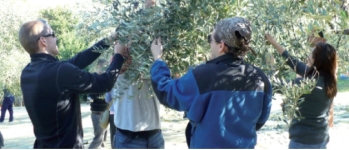
Oenogastronomic Routes and Tourism
Olive oil in “le Marche”
14/11/2008
There is conclusive evidence of olive agriculture in Roman times, in a description from
the third century B.C of a tribute in oil that the “Province” had to pay the empire until its fall. In the dark centuries of the Middle Ages, when the stability of the previous life conditions ended, olive cultivation and oil production suffered a dramatic reduction, followed by a changein eating habits towards the consumption of animal fats, mostly from pork.
Monks were largely responsible for saving the cultivation of olives and vines: wine was indispensable for the celebration of the Holy Mass and oil was necessary to perform some of the Sacraments. In this part of the Pontifical State territory , the clergy began to leave the management of the olive groves in the hands of local farmers in exchange for money or a part of the final product, thus laying the foundations of the first sharecropping contracts that would later become the cornerstone of Marchegian agriculture. A good level of oil production was documented once more in 1.200, by the Venetian Merchant Regulations, which established a tribute in oil called "Ripatico" for the vessels that landed on the Po River, inferior for the "oleo de Marchia" than for other Regions, due to its indisputable superior quality, which determined its inclusion in a specific chapter. Between 1.300 and 1.600, production achieved a surplus that was sufficient to export it to the neighbouring Regions, and it became particularly popular in the city of Florence. Today, olive groves cover almost 10,000 hectares, belonging to approximately 30,000 different companies, which are often very small, with a prevalence in the Province of Ascoli Piceno, followed by Macerata, Ancona and Pesaro-Urbino. The main autochthonous cultivars such as the Ascolana Tenera, Ascolana Dura, Carboncella, Coroncina, Mignola, Orbetana, Piantone di Falerone, Piantone di Mogliano, Raggia, Raggiola, Rosciola and Sargano di Fermo are a real wealth that
must be zealously preserved and treasured. There are also other cultivars that are more
diffused throughout the nation, like the Frantoio, Leccino and Moraiolo. At present, the amount of oil produced in Le Marche is quite modest, about 45,000 quintals equal to 0.7%
of the total national production, but its quality often reaches the highest levels, driven by absolute expertise and the significant efforts of the ASSAM, the OLEA and the Producer
Association. The prospects for the future are brilliant, especially if the production of high quality monovarietal oils can be increased, in order to introduce them to the market as
emissaries of this beautiful region.
Renzo Ceccacci
Collaboration with Italcook Master Italian Cooking:








